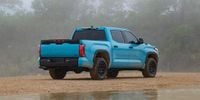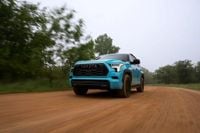On July 22, 2025, Toyota unveiled the 2026 updates for its full-size Tundra pickup truck, delivering a range of thoughtful enhancements that aim to boost comfort, convenience, and off-road capability without a full redesign. Though the changes are mostly incremental, they reflect Toyota’s commitment to keeping its flagship truck competitive in a crowded market.
The 2026 Toyota Tundra lineup remains largely familiar, continuing to offer seven trims: SR, SR5, Limited, Platinum, 1794 Edition, TRD Pro, and Capstone. Buyers can choose between the Double Cab and the longer Crew Cab body styles, both with four doors, and three bed lengths—5.5 feet, 6.5 feet, or 8.1 feet—though not all configurations are available across every trim.
Under the hood, the Tundra carries over its two potent powertrain options without change. The base i-Force twin-turbo 3.4-liter V6 delivers 389 horsepower and 479 lb-ft of torque, except on the entry-level SR model, which offers a slightly detuned 348 hp and 405 lb-ft. The more powerful i-Force MAX hybrid version combines the same V6 with an electric motor, boosting output to 437 hp and a hefty 583 lb-ft of torque. Both engines pair with a 10-speed Electronically Controlled Automatic Transmission with intelligence (ECTi), featuring sequential shift mode and Tow/Haul settings. When properly equipped, the Tundra can tow up to 12,000 pounds, maintaining its reputation as a workhorse.
One of the most notable mechanical upgrades for 2026 is the standardization of a larger 32.2-gallon fuel tank across all trims, eliminating the smaller 22.5-gallon option previously found on the SR and SR5 models. This enhancement extends driving range and removes buyer confusion over fuel capacity options.
On the exterior, the 2026 Tundra TRD Pro gains a striking new exclusive paint color dubbed “Wave Maker,” a vivid aqua blue hue shared with the 2026 TRD Pro versions of the Tacoma, Sequoia, and 4Runner. This bold color is designed to catch eyes on and off the trail, reinforcing the TRD Pro’s rugged and adventurous character.
Inside, the Capstone trim receives a refined interior update featuring Shale premium textured leather-trimmed seats with a subtle brown stripe down the center, lending an upscale and distinctive look. The Limited trim also upgrades to leather seats available in black with white stitching or gray with black stitching, enhancing comfort and style across the lineup.
Perhaps the most innovative interior addition is the availability of IsoDynamic shock-absorbing front seats on the TRD Pro trim. These seats, first introduced on the Tacoma TRD Pro, use adjustable air pressure chambers and shock absorbers to smooth out rough terrain impacts, significantly improving occupant comfort during off-road adventures. Unlike the Tacoma, where these seats intrude heavily on rear legroom, the Tundra’s larger cabin space likely mitigates this issue, making the seats a practical option for drivers who demand both comfort and capability.
Rear passenger comfort also sees improvements with the addition of air vents on the rear center console for Double Cab models, ensuring better airflow to the back seats. Furthermore, all Tundra trims equipped with single-zone climate control now feature Toyota’s smartflow management system, also known as “S-Flow,” which intelligently directs airflow only to occupied seats, enhancing energy efficiency and passenger comfort.
Additional convenience features include a tow hitch and 7/4-pin trailer connector becoming standard equipment across the entire Tundra range, streamlining towing readiness. Power-deploying running boards are now available as optional extras on the Platinum trim and 1794 Edition models equipped with the TRD Off-Road package, adding style and easier access. The SX package also sees an upgrade, now featuring 20-inch wheels instead of the previous 18-inch versions, contributing to a more aggressive stance.
For off-road enthusiasts, the TRD Rally package, introduced in 2025 as a limited-edition upgrade with body-color accents and Toyota Racing graphics, now offers an optional 3-inch TRD lift kit. This kit includes taller TRD springs, Bilstein dampers, and aluminum upper control arms, boosting ground clearance and suspension performance for tackling challenging terrain. The package also bundles in the Tow Tech features, making it a comprehensive off-road and towing upgrade likely to cost over $10,000.
Mechanically, the 2026 Tundra continues to include Toyota’s renowned safety suite, Toyota Safety Sense 2.5, standard on every model. This package comprises a Pre-Collision System with Pedestrian Detection, Full-Speed Range Dynamic Radar Cruise Control, Lane Departure Alert with Steering Assist, Lane Tracing Assist, Road Sign Assist, and Automatic High Beams. A rear seat reminder system is also standard, promoting occupant safety.
Pricing details for the 2026 Tundra have not been officially announced, but industry experts anticipate only modest increases compared to the 2025 model year. The base SR trim started at $40,090 in 2025, with the Capstone range-topping model reaching $80,725. The entry-level SR model is expected to see the largest price bump, approximately $1,270, largely due to increased destination charges.
Toyota plans to have the 2026 Tundra available in dealerships by fall 2025, ensuring that buyers can access these updates before the end of the year. While the truck’s overall design and powertrain remain consistent with previous years, these carefully curated enhancements underscore Toyota’s strategy of refining rather than radically altering its flagship pickup.
Overall, the 2026 Toyota Tundra strikes a balance between rugged capability and refined comfort. The introduction of shock-absorbing IsoDynamic seats, expanded leather options, and practical features like larger fuel tanks and standard towing hardware make it a more versatile and appealing choice for a wide range of truck buyers. The new Wave Maker paint and off-road package upgrades add personality and capability, ensuring the Tundra remains a strong contender in the competitive full-size pickup segment.






